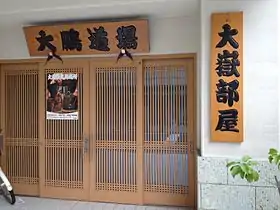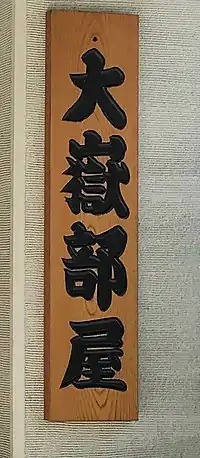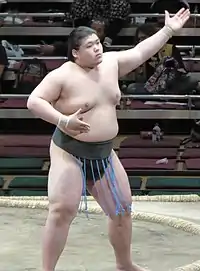Ōtake stable
Ōtake stable (大嶽部屋, Ōtake-beya) is a stable of sumo wrestlers, part of the Nishonoseki group of stables.


History
The stable was established in 1971 as Taihō stable by the 48th yokozuna Taihō Kōki upon his retirement from wrestling. The stable branched off from Nishonoseki stable. The first sekitori the stable produced was Shishihō in 1977. The most successful wrestler was Ōzutsu, who reached the rank of sekiwake. In May 1981 Taihō was persuaded by the editor of the English language sumo magazine Sumo World to accept a foreign wrestler, Philip Smoak of Texas, who was with the stable for just two months.[1]
In 2003 Taihō passed control of the stable on to his son-in-law, former sekiwake Takatōriki since Taihō was approaching the age for mandatory retirement from the Japan Sumo Association. As the name of Taihō was an ichidai-toshiyori (one-generation elder name) it could not be passed on, so the stable was re-named Ōtake. In 2004, the Russian Rohō reached the top division and achieved his highest rank of komusubi but he was dismissed from sumo in September 2008 after failing a test for cannabis.
In January 2010 the stable, along with the Takanohana, Ōnomatsu and Magaki stables, were ejected from the Nishonoseki ichimon after Takanohana declared his intention to run as an unofficial candidate in the elections to the Sumo Association's board of directors. The ejected stables formed their own group, which gained ichimon status in 2014.[2][3] In 2018 the stable joined the Nishonoseki ichimon.
In July 2010, Ōtake, the former Takatōriki, was dismissed from the Sumo Association for his involvement in a scandal over illegal betting. The stable was taken over by the former jūryō wrestler Dairyū, who had been working as a coach at the stable under the name Futagoyama. In 2013, the Egyptian Ōsunaarashi reached the top division in 2013 but he was forced to retire in March 2018 after being caught driving without a license.
As of May 2023, the stable had 13 active wrestlers.
The stable still displays the red tsuna that Taihō wore while performing his kanreki dohyo-iri ceremony in 2000.[4]
In January 2018 a grandson of Taihō, Naya Kōnosuke, joined the stable.[5] Naya was promoted to jūryō for the January 2021 tournament and changed his name to Ōhō. He is the second member of the stable to reach jūryō since the former Dairyū took over as head coach, following Ōsunaarashi.[6] Another grandson of Taihō, Mudohō Kōsei, joined in November 2019, and a third, Naya Takamori, in March 2020, but neither has achieved sekitori status.
Ring name conventions
Many wrestlers at this stable take ring names or shikona that include the character 大 (read: ō or dai), which is used in the first character of the stable's name and also is in deference to the last two owners, whose former shikona also included this character. Examples of wrestlers who have incorporated this include Ōsunaarashi, Ōsuzuki, Daiseiryū and Dairyūki.
Owners
- 2010-present: 17th Ōtake (Iin former jūryō Dairyū)
- 2003 - 2010: 16th Ōtake (former sekiwake Takatōriki)
- 1971 - 2003: Taihō Kōki (the 48th yokozuna, Taihō)
Notable active wrestlers
 Ōhō is a grandson of the stable's founder, Taihō
Ōhō is a grandson of the stable's founder, Taihō![Another grandson, Mudohō [ja]](../I/Mudoho_Kosei2022015.jpg.webp) Another grandson, Mudohō
Another grandson, Mudohō
- Ōhō (best rank, maegashira)
Notable former members
- Ōzutsu (former sekiwake)
- Rohō (former komusubi)
- Shishihō (former maegashira)
- Ōnohana (former maegashira)
- Ōsunaarashi (former maegashira)
- Ōwakamatsu (former maegashira)
Ushers
Hairdresser
- Tokonao (3rd class tokoyama)
Location and access
Tokyo, Kotō ward, Kiyosumi 2-8-3
3 minutes from Kiyosumi-shirakawa Station on the Toei Ōedo Line and Hanzōmon Line
See also
References
- Gunning, John (8 August 2018). "Entering sumo world not something to be taken lightly". Retrieved 11 September 2018.
- "Takanohana speaks out after six supporters kicked out of sumo faction". Mainichi Daily News. 20 January 2010. Archived from the original on 24 January 2010. Retrieved 1 August 2015.
- "Takanohana group certified as ichimon". Nikkan Sports. 24 May 2014. Retrieved 12 March 2015.
- Gunning, John (8 July 2020). "Sumo's unique kanreki ceremonies provide windows into past". Japan Times. Retrieved 8 July 2020.
- "Family legacy weighs heavily on young sumo prospects". Japan Times. 18 April 2018. Retrieved 24 July 2018.
- "2021 January Grand Sumo Tournament Banzuke Topics". Japan Sumo Association. Archived from the original on 29 December 2020. Retrieved 29 December 2020.